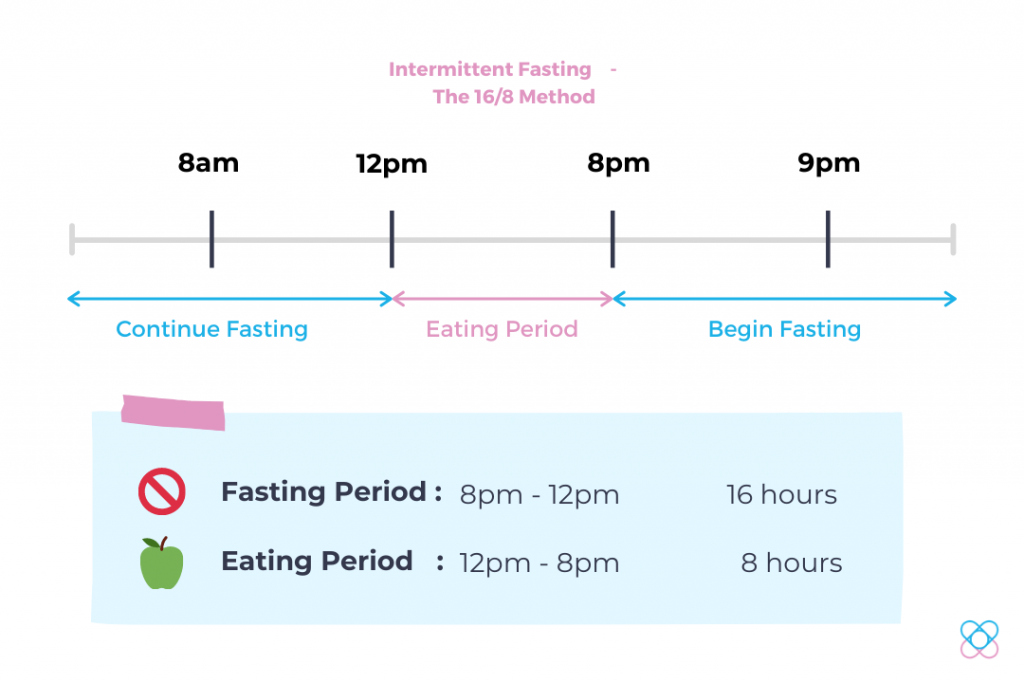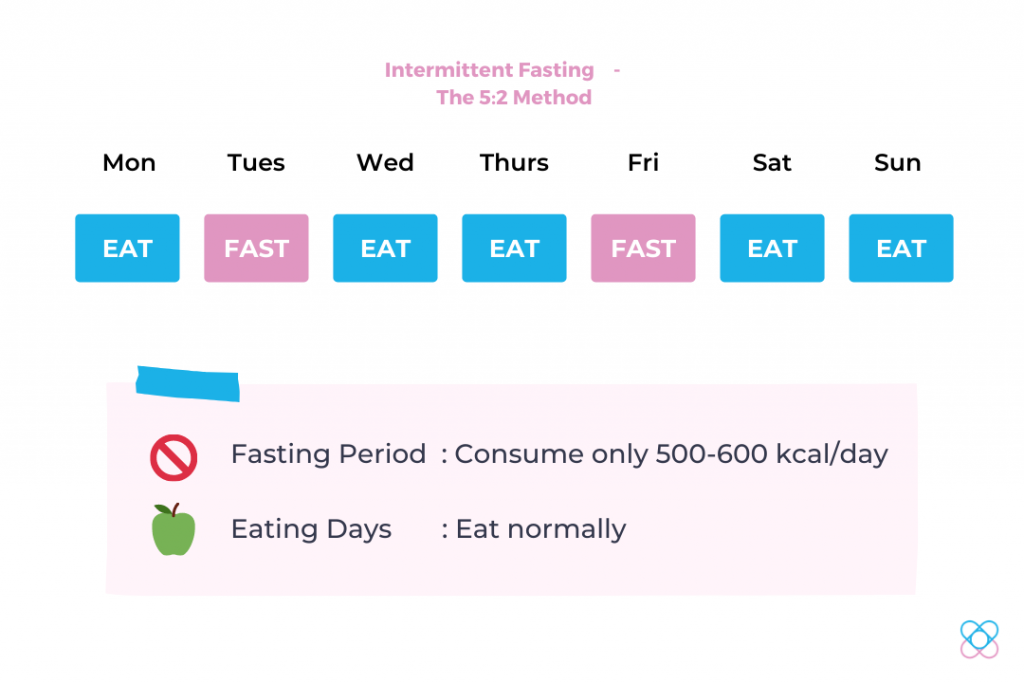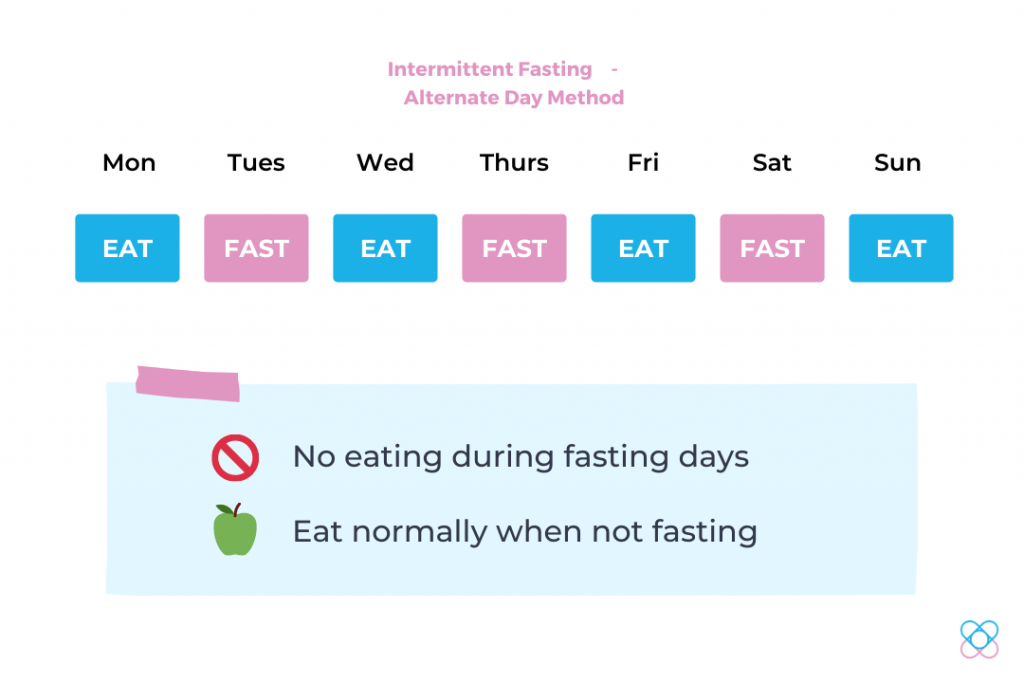
Intermittent fasting – what is it?
Intermittent fasting emerged for a long time and received much positive feedback because of its potential health benefits. It was one of the most searched terms for weight loss in 2019. In fact, intermittent fasting has earned its reputations and turned into one of the popular trends in the fitness and health community.
So what’s so special about intermittent fasting? Let’s explore and get to know more about it!
What is Intermittent Fasting?
Intermittent fasting is described as an eating pattern that cycles between periods of fasting and eating. The term, intermittent fasting is used interchangeably for health reasons or weight loss. It is usually done by a specific group of people to seek for improving health, modifying lifestyles or losing weight. It is also commonly practised for cultural or religious reasons, such as Ramadan[12].
Intermittent fasting is similar to caloric restriction, as it is using the principle of limiting food intake. However, intermittent fasting usually emphasises on the timing of when to eat, for instance, eating during a specific time of period or fasting for an entire day.
One good thing about intermittent fasting is that individuals do not have to count calories, rather than just paying attention to the time when they can consume food.
Methods of Intermittent Fasting
Intermittent fasting can be divided into the following categories as below [9,10,12]:
16/8 method
The 16/8 method is referring to “time-restricting feeding.” The “16” refers to the period of fasting, the “8” refers to the window period for consuming food. It is usually practised on a daily basis. For instance, finishing dinner at 9 pm, then proceed to fast from 9 pm to 12pm of the following day.

5:2 Diet
It is also known as the fast diet, where you are restricted to consuming only a total of 500 – 600 calories throughout the fasting day. Then, eat normally for the remaining 5 days. Fasting usually takes place two days per week.

Alternate-day Fasting
This involves fasting for 24 hours, taking place 1 – 3 times per week. During the period of fasting, it is recommended to consume only calorie-free beverages such as water or restricted to consume up to 500kcal per day. On non-fasting days, it is permitted to eat normally [11]. An example of the fasting schedule would be fasting on Monday, Wednesday and Friday, then eating normally on the remaining days.

Benefits of Intermittent Fasting
Intermittent fasting has been showing effects to individuals suffering from obesity, high cholesterol and irritable bowel syndrome[4,8]. According to the research done by the New England Journal of Medicine in 2019, intermittent fasting has been shown to have an effect on obesity and improve insulin sensitivity in type 2 diabetic patients[2].
The potential benefits of intermittent fasting include[2,4,5,8]:
- Improve blood sugar regulation
- Improve blood pressure
- Reduce blood lipids levels
- Increase resistance to stress
- Suppresses inflammation
- Promote weight loss
Drawbacks of Intermittent Fasting
Although intermittent fasting possesses a lot of benefits, the individual’s body may respond differently and affect health.
The drawbacks of intermittent fasting include[1,5] :
- Insomnia
- Nausea
- Disrupted sleeping patterns
- Increase feelings of hunger
- Difficulties in concentrating
What to Eat while Fasting and Not Fasting
During the fasting period, dehydration and low blood pressure may occur, therefore it is essential to consume non-caloric fluid such as water, unsweetened coffee or tea[6,7].
During the eating period, it is vital for individuals to take note of the food choices every day even though intermittent fasting does not really emphasize on what to eat. In fact, it is advised to “eat normally,” but it does not mean going crazy to search for high caloric kinds of food such as junk food or super-sized fried items[6,7].
Although intermittent fasting allows individuals to eat and enjoy a range of types of food, it is still essential to take account of exactly what you are consuming during the eating periods[6]. Studies have shown that to carry out the full effectiveness of intermittent fasting, it is best to accompany it with the combination of types of food consumed and physical activity[7].
Individuals Who Should Be Careful or Avoid Intermittent Fasting
Intermittent fasting is certainly not for everyone, especially for people who have a history of eating disorders (eg. Anorexia Nervosa) or underweight[3,4]. Besides, it is also inappropriate for: people with type 1 diabetes; pregnant and breastfeeding women; women who try to conceive; elderly and active growth (< 18 years old) individuals; and those in need of regular food intake to take medications[3,4]. Hence, it is recommended to seek advice from medical professional practitioners before proceeding to intermittent fasting.
Wondering whether intermittent fasting is suitable for you as an option for weight management? Find out if dieting to lose weight is suitable for you with DNA Explorer Personal.
References
1. Bennifer, B. (2019). Intermittent Fasting and its Health Implications: A Review. Acta Scientific Nutritional Health, 3(5), 134-137.
2. Cho, Y., Hong, N., Kim, K., Cho, S., Lee, M., & Lee, Y. et al. (2019). The Effectiveness of Intermittent Fasting to Reduce Body Mass Index and Glucose Metabolism: A Systematic Review and Meta-Analysis. Journal Of Clinical Medicine, 8(10), 1645. doi: 10.3390/jcm8101645
3. Kavitha, G., Yacob, H., & Senan, S. (2018). Intermittent Fasting: The Choice for a Healthier Lifestyle. Cureus. doi: 10.7759/cureus.2947
4. Harvard T.H. Chan. (2020). Diet Review: Intermittent Fasting for Weight Loss. [Online] Retrieved 11 September 2020, from https://www.hsph.harvard.edu/nutritionsource/healthy-weight/diet-reviews/intermittent-fasting/
5. Harvie, M., & Howell, A. (2017). Potential Benefits and Harms of Intermittent Energy Restriction and Intermittent Fasting Amongst Obese, Overweight and Normal Weight Subjects — A Narrative Review of Human and Animal Evidence. Behavioral Sciences, 7(4), 4. doi: 10.3390/bs7010004
6. Malinowski, B., Zalewska, K., Węsierska, A., Sokołowska, M., Socha, M., & Liczner, G. et al. (2019). Intermittent Fasting in Cardiovascular Disorders—An Overview. Nutrients, 11(3), 673. doi: 10.3390/nu11030673
7. Patterson, R., Laughlin, G., LaCroix, A., Hartman, S., Natarajan, L., & Senger, C. et al. (2015). Intermittent Fasting and Human Metabolic Health. Journal Of The Academy Of Nutrition And Dietetics, 115(8), 1203-1212. doi: 10.1016/j.jand.2015.02.018
8. Rafael, d., & Mark, P. (2019). Effects of Intermittent Fasting on Health, Aging, and Disease. New England Journal Of Medicine, 381(26), 2541-2551. doi: 10.1056/nejmra1905136
9. Tinsley, G., Gann, J., & La Bounty, P. (2015). Intermittent Fasting Programs and Their Effects on Body Composition. Strength And Conditioning Journal, 37(5), 60-71. doi: 10.1519/ssc.0000000000000160
10. Tiffany A., D., Pratik B., S., Devinder S., D., Anurag, M., Laura C., A., & Allen L., D. et al. (2020). Intermittent Fasting: A Heart Healthy Dietary Pattern?. The American Journal Of Medicine, 133(8), 901-907. doi: 10.1016/j.amjmed.2020.03.030
11. Trepanowski, J., Kroeger, C., Barnosky, A., Klempel, M., Bhutani, S., & Hoddy, K. et al. (2017). Effect of Alternate-Day Fasting on Weight Loss, Weight Maintenance, and Cardioprotection Among Metabolically Healthy Obese Adults. JAMA Internal Medicine, 177(7), 930. doi: 10.1001/jamainternmed.2017.0936
12. Volpe, S. (2019). Intermittent Fasting — What Is It and Does It Work?. Acsmʼs Health & Fitness Journal, 23(1), 34-36. doi: 10.1249/fit.0000000000000444





